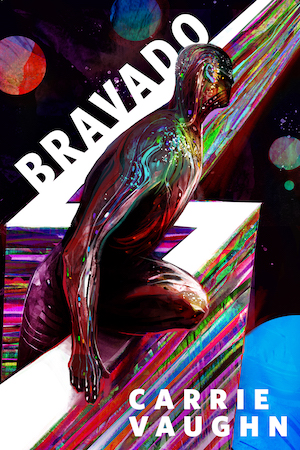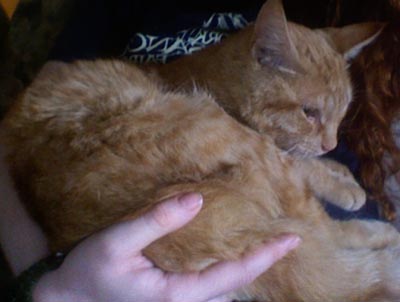I am proud to announce that I’m a Crazy Cat Lady in Training (and no, we won’t refer to that as a CCLiT, really). It is possible that I was put on Earth pretty much solely to provide an audience for all those books about cats. Not the “how to talk to your cat” or “cat solves a mystery but then cannot communicate with dumb humans!” kind, but the cats in space! or cats with magic! or cats with 6 limbs who are telepathic! books. I’m a total sucker for those. Prominently displayed on my bookshelves are Diane Duane’s Book of Night With Moon and To Visit The Queen. I recently started reading the Honor Harrington series and want a treecat so badly it hurts. I got Anne McCaffrey’s Catalyst as a gift this past winter, and let’s not even talk about how much Sabrina’s Salem and the cats in Tanya Huff’s Summon the Keeper series made me happy throughout high school.
For all that I love books about cats (and don’t get me wrong, also foxes and ponies and dogs and polar bears), when I start a new one, I’m always a little worried. When I was relatively young, my stepmother warned me away from all animal books because animals basically eat and die. She put it much less bluntly, I’m sure, but it’s pretty much always held true. Unfortunately she didn’t get to me in time to warn me off Black Beauty, but otherwise her advice has generally stood me in good stead. So, much as I hate when they’re too cutesy and kitsch-y, I actually prefer books that over-personify animals because then you know they have a chance of doing something other than dying. Of course, sometimes it’s just worth it anyway, like in Janni Lee Simner’s Bones of Faerie when [SPOILER ALERT: highlight to read] she kills the cat (actually, or in her new book Thief Eyes when she, kinda, kills the fox). Sometimes it’s the only realistic, sensible thing to do and if you don’t, you run the risk of being overly “precious” with them. I may not like it, but I get it. What I hate though, is when authors Cedric Diggory an animal (you know it’s true).
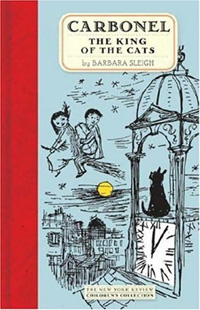
Recently a very good friend (she may have been only a good friend before; she’s been promoted) gave me Carbonel, The King of Cats by Barbara Sleigh. Carbonel, WHERE HAVE YOU BEEN ALL MY LIFE? I have vague recollections of maybe reading this as a child; the scene with the china shop and the rainbow magic sounded remarkably familiar, but apparently there are two more whole books? I may explode from joy.
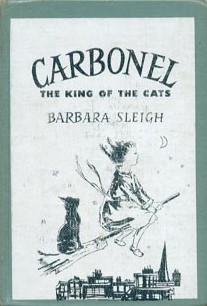
Carbonel was first published in 1955 and feels like it, with a children’s book sensibility that I really like. There’s a nice, grounded feeling from the characters and the family; it’s occasionally a little Horatio Alger-y, but the characters are honestly likable, and it delves into fairy-tale quickly and amusingly enough to make me happy. It feels remarkably like an E. Nesbitt or Edward Eager book. I also really admire kids’ books that go on unbelievable, magical adventures while navigating the grown-ups in their lives successfully and realistically; not to mention having the children sometimes successfully help the grownups instead of the other way round. (In Carbonel, they also try to tell a couple adults of about the magic, who then make—not particularly funny—jokes about it throughout the rest of the book. It felt very realistic.) All of this plus broom rides, badly made magic spells, a (moderately) evil witch who makes bad sweets and helping a King regain his throne. I’m certainly going to try to get my 10-year old sister to read it. Although with her current insistence on only reading things that “aren’t babyish” and are “old enough” for her, I’m going to have to try and find one with the newest, and in my opinion, ugliest of the covers.
There is cat-on-cat violence towards the end of the book and the children have to figure out how to help their friend mid-battle, but there is no death. (Possibly because there are two more books?) Because the cat can talk, you have a huge investment in his character, goals, and storyline and particularly when he is grumpy and snarky, it is hard to think of him as a precious pussums. In fact the only characters who treat the animals as adorable and not-human are the same adults who tend to look down on the children in the book too.
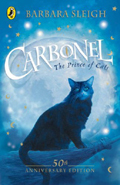 Carbonel—and others like it—prove that there is a way to walk that fine line between being too cutesy or overpersonifying and killing animals off constantly, but I think it’s not done well nearly often enough. I tend to judge books to be the former if they have entire cat-languages (with, again, the exception of Diane Duane who I thought pulled it off) whereas more realistic books about animals, like perhaps Marguerite Henry’s Chincoteague series of books or certainly a lot of animal movies, are often heartbreaking and definitely often fall into the latter category. Especially to the delicate little flower I was as a child. Homeward Bound scarred me for life. Who just forgets their pets? I definitely thought that if they could just forget their pets like that, obviously they could just as easily forget their children. The children in the books are often lonely and look to their pets for companionship and love, which makes it all the more horrifying when they just die or are abandoned or forgotten. I never read much of the Redwall series, but am interested in how they do it because, as far as I know, it’s very personified. I do vaguely remember reading The Animals of Farthing Wood (I think that was actually the one my step-mother commented on) and some creatureperson died horribly, which is doing it wrong in my opinion.
Carbonel—and others like it—prove that there is a way to walk that fine line between being too cutesy or overpersonifying and killing animals off constantly, but I think it’s not done well nearly often enough. I tend to judge books to be the former if they have entire cat-languages (with, again, the exception of Diane Duane who I thought pulled it off) whereas more realistic books about animals, like perhaps Marguerite Henry’s Chincoteague series of books or certainly a lot of animal movies, are often heartbreaking and definitely often fall into the latter category. Especially to the delicate little flower I was as a child. Homeward Bound scarred me for life. Who just forgets their pets? I definitely thought that if they could just forget their pets like that, obviously they could just as easily forget their children. The children in the books are often lonely and look to their pets for companionship and love, which makes it all the more horrifying when they just die or are abandoned or forgotten. I never read much of the Redwall series, but am interested in how they do it because, as far as I know, it’s very personified. I do vaguely remember reading The Animals of Farthing Wood (I think that was actually the one my step-mother commented on) and some creatureperson died horribly, which is doing it wrong in my opinion.
Also, in case I talked too much, have all the cute in the universe:
So what books do it right? (Extra points if they have cats in them, or cat-shaped creatures.)
Nina Lourie is entirely mesmerised by tiny baby leopard cubs with their tiny pointy tails. Tybalt (see furry mass at top of post) is a 10 month old ginger part-Maine Coon kitten currently staying with Nina and looking for a forever home.


